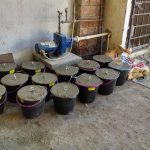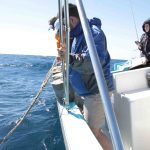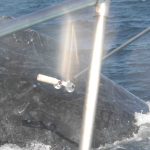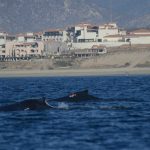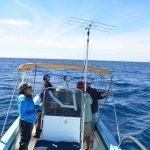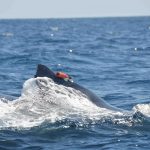Here are a selection of photos and figures related to the 2014 field experiment. Photo credits: E. Jimenez, P. Martinez and J.C. Salinas/PRIMMA-UABCS
- Based on previous year’s experience, the project realized that bottom recorders could be deployed using the UABCS vessel “Yubarta”: the rental of a fishing vessel was not needed. To achieve this the group built a series of concrete anchors on-site, using 2.5 gallon buckets, which weighed 50 lbs. each and thus could be transported by hand onto the panga. Unfortunately, PI Thode learned the hard way that concrete anchors need to set for 48 hours before being deployed.
- Four of concrete weights clustered together yielded 200 lbs. of in-air weight and 120 of submerged weight, which was sufficient to counter the 80 lbs. of subsurface flotation employed by two 714 Trawlworks floats (14’’ diameter). Two people working together could lift the combined weight over the side and thus deploy the system without mechanical assists. Here the 2014 Cerros Colorados station is about to be deployed by Jit Sarkar, Jorge Urban, and A. Thode
- All gear at a given site was attached to a SubSeatronics AR60E acoustic release, which could be interrogated from a surface transducer to yield the release’s battery health and distance from the interrogating vessel. Diana Lopez watches as Kerri Seger prepares the interrogator.
- Kerri Seger and Juan Carlos Salinas deploy a HOBO weather station at Pt. Ballena, close to Cabo San Lucas.
- Acoustic tags are deployed using a press-fit PVC connector on the end of a boat pole. Here UABCS researcher Esther Jimenez prepares to tag an animal.
- An Acousonde moments before being attached. The non-invasive suction cups can grip the animal anywhere between 2 to over 10 hours, depending on the age of the suction cup.
- An Acousonde tag deployed on a humpback whale.
- An Acousonde tag on a mother, deployed on Feb. 14 for 10 hours:
- Once an animal is tagged, a directional VHF antenna is used to detect the tag when an animals surfaces.
- Acousonde deployed on cow/calf pair, Feb. 21.

